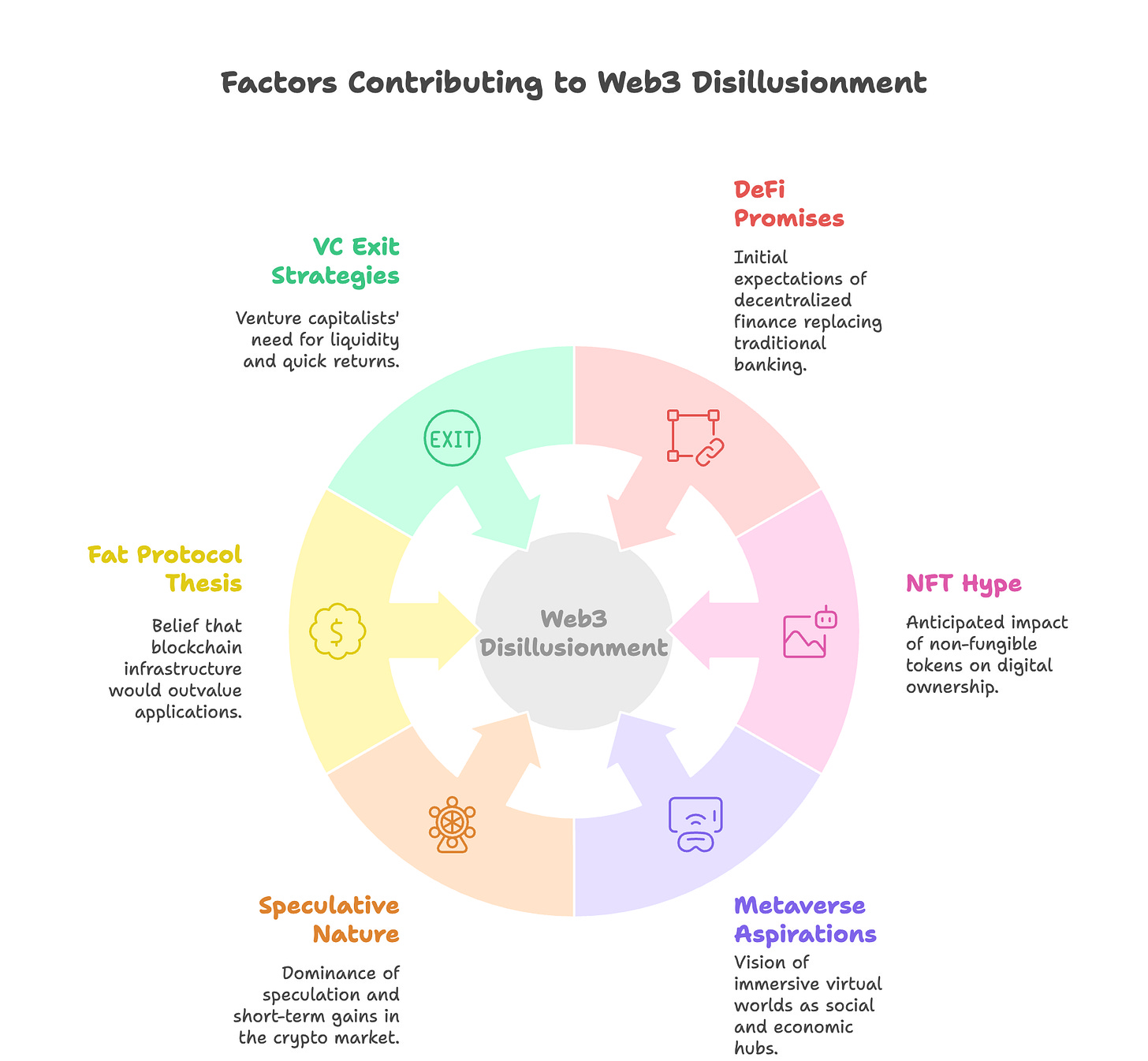Нова реальність криптовалюти: від Дикого Заходу до Волл-стріт
Старожили втомилися, новачки зруйновані, але гра ще не закінчена. Адаптуйся або помри
Це не просто ще один криптографічний цикл - це, як улюблений підземний бар, який купили і перетворили на шикарний коктейль-лаунж. Дегени та роздрібні гравці, які колись керували місцем, лікують свої рани, тоді як великі гравці - хедж-фонди, фонди суверенного багатства та титани TradFi - входять з костюмами на замовлення та алгоритмічними стратегіями, готові взяти верх.
Крипто OGs? Вони бачили більше драми, ніж об'єднання реаліті-шоу — розпади Mt. Gox, казино ICO, літній роман DeFi та золота лихоманка NFT, яка перетворилася на розпродаж. Тепер вони сподіваються побачити швидке повернення біткоїна до рівня 120-150 тис. доларів і думають, чи це буде час зняти гроші, як у відходячого покерного професіонала, або ж є ще одна дика карта для гри.
Дякую за читання Rising Hashtalk! Підпишіться безкоштовно, щоб отримувати нові публікації та підтримувати мою роботу.
Але давайте будемо чесні - крипто не вмирає; вона лише отримує корпоративний мейкап. Тут з'являється група людей, які люблять побалувати себе, і правила гри змінюються. Питання таке: ви адаптуєтеся, чи ви ще той хлопець, який запитує, чи може Dogecoin досягнути $10?

1. Ринок не той, що колись був
Крипто схоже на те дике, беззаконне прикордонне містечко, яке тільки що отримало Starbucks та міську раду - анархія зникає, а інституції наближаються. Пройшли часи, коли мем та мрія могли принести вам 100 разів більше грошей за ніч. Нова гра? Костюми, регуляція та макроекономічний шахи.
Новий керівник Біткоїна: Макроекономіка, а не казкове подвоєння
Якщо ви все ще вважаєте, що ціна біткоїна визначається виключно чотирирічним циклом, ви схожі на людину похилого віку, яка чекає, коли підключиться найпоширеніше з'єднання з Інтернетом - відірвана від реальності. Біткоїн тепер є макроактивом, реагуючим на процентні ставки, глобальну ліквідність та економічний настрій ризику, як досвідчений трейдер з Волл-стріт, який перевіряє облігаційні доходи перед придбанням авокадо-тостів. Якщо ви не розумієте макро, ви приносите спіннер для розумової гри.
Роздріб вийшов, в інституціях
Пам'ятаєте, коли ваш водій Uber і ваш перукар рекламували альткоїни і обговорювали плату за газ Ethereum? Так, ці дні минули. Тепер це BlackRock, суверенні фонди та гіганти TradFi визначають умови. ETF вклали мільярди в цей простір, але вони також перетворили Bitcoin у корпоративний актив - менше схожий на дикого жеребця, більше на акції Tesla з додатковою драмою.
Розрив у ліквідності: Bitcoin та ETH отримують VIP, Alts залишаються за дверима
Інституційні кошти вливаються в BTC, ETH, та кілька синіх фішок, як шампанське на яхті мільярдера. Все інше? Ліквідність висохає швидше, ніж ваше рішення походити в спортзал на Новий рік. Багато менших альткоїни перетворюються на привидні ланцюги — переслідувані мріями про минулі ходи биків та власниками кошельків, які відмовляються продавати.
Ефект Трампа: Магія мемів або пастка ліквідності?
Радикально нова позиція Трампа стосовно криптовалюти внесла свіжу енергію на ринок, з розмовами про Стратегічний резерв біткойну США та штовханням до прискорення регулювання стейблкоїнов. Але ось цей момент — його казино мемкойнів ($TRUMP, $MELANIA) стало чорною дірою ліквідності, висмоктуючи дегенеративні кошти і залишаючи широкий ринок задихаючимся від повітря. Це схоже на карнавал, де кожен витрачає свій останній долар, намагаючись виграти великого ведмедя, лише щоб зрозуміти, що вони не можуть дозволити собі поїздку додому.

2. Web3 Обіцяла революцію, але де корисність?
Web3 мав змінити світ, але замість цього відчувається, що ми отримали буфет у Лас-Вегасі - багато шуму, кілька смачних страв і багато шкідливої їжі. DeFi мав замінити банки, NFT мали переосмислити власність, а Метавсвіт мав стати місцем, де варто бути. Проте після всіх обіцянок на мільярд доларів, єдине, що насправді використовують люди? Стейблкоіни.
Єдина справжня Killer App: Stablecoins (тобто Fancy Internet Dollars)
Забудьте про революції у сфері криптовалют та імперії NFT — єдине, що криптовалюта справді вдалося, це створення цифрових доларів з меншою кількістю посередників та трохи кращими вібраціями. Якщо б Web3 був науково-фантастичним фільмом, стейблкоїни були б єдиним шматком інопланетної технології, яка дійсно працює, тоді як все інше — це лише концепції та фанатські теорії.
Економіка шахрая: спекуляція все ще головна подія
Крипто все ще працює як карнавал з високими ставками Понзі, де мем-монети, впливові помпи та дампи, і переоцінені «наступне покоління» ланцюги (TIA, SEI, MONAD, BERACHAIN) запускаються з оцінками понад $5 млрд, перш ніж хтось навіть скористається ними. Це схоже на відкриття ресторану п'ятизіркового рівня, витрачення мільйонів на маркетинг, а потім забутня про те, щоб найняти шеф-кухаря.
Теза "Товстого протоколу" офіційно вибухнула
Протягом років тезис Fat Protocol крипто вважав, що інфраструктура блокчейну повинна бути вартішою, ніж додатки, побудовані на ній. Виявляється, це було схоже на інвестування в дороги та очікування, що вони будуть вартішими, ніж міста, які вони з'єднують. У той час як реальні бізнеси торгуються за 5-15х Ціна/Оборот, деякі застійні L1s та L2s все ще утримують множники 150x-1000x, незважаючи на відсутність зростання. На цей момент деякі з цих ланцюгів схожі на тематичні парки без атракціонів — лише переплачені вхідні квитки і багато невиконаних обіцянок.
VCs Still Need Exit Ліквідність (І Ви Це)
Багато цих «інноваційних» проектів існують виключно як стратегія виходу для ранніх інвесторів, точно так само, як і манія ICO 2017 року. Якщо проект падає з миттєвим розблокуванням токенів і повністю розведеною оцінкою, більшою, ніж у Coinbase, вітаємо - ви не інвестуєте, ви - вихідна ліквідність. Це схоже на купівлю будинку, лише щоб усвідомити, що попередній власник продав вам землю, стіни, і навіть повітря всередині кімнат окремо.

3. Крипто: Біженці з мозку: Будівельники переїхали до штучного інтелекту
Топ-розробники Крипто втікають до штучного інтелекту, як щури з потопаючого корабля - або, точніше, як впливові особистості Web3 видаляють свої твіти "Децентралізовано завжди" та перефарбовуються як лідери думки в галузі штучного інтелекту за ніч.
Чому розробники покидають Крипто на користь штучного інтелекту?
Тому що штучний інтелект - це нове, тоді як крипто - це старе рок-зірка, яка все ще намагається розпродати стадіони на підставі хіта з 2017 року.
- Чіткіші Положення – ШІ схожий на обіцяючого, але трохи жахливого дитину-генія — уряди не впевнені, чи слід доглядати за ним, чи тримати під наглядом. Крипто? Все ще поводиться як бунтівний підліток, який витратив усі гроші бабусі на собачі монети.
- Краще фінансування - Венчурні капіталісти кидають гроші на штучний інтелект, ніби це наступний Google, тоді як засновники криптовалюти застрягають на виголошенні свого 12-го "революційного" L1 перед залом, наповненим порожніми стільцями.
- Менше циклів бумів та спадів – ШІ схожа на стабільного, високоуспішного студента-відмінника. Крипто? Дитина, яка або перемагає на науковій виставці, або підпалює лабораторію—немає проміжних варіантів.
Велика міграція Web3 → AI
Ті самі "візіонери", які обіцяли децентралізувати світ, зараз навчають моделі штучного інтелекту писати корпоративні електронні листи та створювати підозріло реалістичні deepfakes.
- Крипто хотіла замінити банки.
- Штучний інтелект просто хоче замінити вас.
На цьому етапі в криптовалюті залишилися лише справжні прихильники або люди, які занадто ліниві оновлювати свій LinkedIn.
4. ОГі виводять гроші, але гра ще не закінчена
Криптоветерани - ті, хто вижив після Mt. Gox, манії ICO, витягування килиму DeFi і фази "ой, я випадково відправив усі свої інвестиції на неправильну адресу" - нарешті знімають гроші. Вони тут достатньо довго, щоб знати, що коли BlackRock починає купувати Bitcoin, дні експоненційних прибутків закінчилися.
Куди вони йдуть?
- Штучний інтелект та технології – Тому що чому грати на мемо-монетах, коли можна створити алгоритм, який замінить фінансових аналітиків?
- Нерухомість — Після років стейкінгу, фермінгу валют та маржинальної торгівлі, можливо, найбільш вигідним варіантом стане купівля будинку в Маямі.
- Часткова пенсія - деякі OG вже настільки втомилися від перевірки CoinGecko о 2 годині ранку, що вони переїхали на тропічні острови і тепер розмовляють лише мовою біткоїн-максиспік.
Але Інституції Беруть Верх
Те, що ОГи залишаються, не означає, що крипто вмерло. Навпаки, великі фінансові установи входять в гру, як брокери з Уолл-стріт, які відкривають для себе DeFi літо два роки занадто пізно.
Крипто вже не лише майданчик для дегенератів та азартних гравців — вона розвивається. Казино все ще відкрите, але тепер Goldman Sachs володіє ігровими автоматами.
Так отже, питання таке: Ви готові до наступного розділу, чи ви тут лише для FOMO в наступну мем-монету?
5. Биковий сценарій: новий крипто бум буде виглядати ... інакше
Наступний бум криптовалют буде схожий на того друга, який колись відпочивав занадто жорстко, але зараз з'являється на бранчі в піджаку і насправді замовляє салат замість текіли. Хаос врівноважується, і дикий підліток перетворився на добре вихованого, інвестиційно-рейтингового дорослого - ну, якось так.
Регулювання нарешті набирає форму
Крипто отримує оновлення - як класний баламут, який раптово став Президентом студентської ради. Він все ще шахрайливий, але тепер у нього є блискучий новий костюм і значок "Давайте дотримуватися правил".
- Комісія з цінних паперів і бірж нарешті вирішила перестати ставити до кожної криптовалютної біржі як до злочинця в фільмі про Бонда. Вони відмовилися від позовів проти Binance, Coinbase, Kraken, Uniswap та інших, ніби нарешті зрозуміли, що криптовалюта не зникне - як той випадок, коли ваш батько перестає сваритися з вами щодо ваших «сумнівних» татуювань.
- Правила брокера DeFi? Ірс, ймовірно, буде змушений припинити спроби зіпсувати усім настрій. Уявіть, що ви кажете своєму дядькові: "Ти можеш продовжувати вечірку - просто нічого не ламай".
- Комітет з банківської справи Сенату збирається голосувати за Закон про стейблкоїн, а Закон про ГЕНІЇ набирає обертів. Це, мовляв, крипто отримує офіційний лист з батьківським дозволом на екскурсію.
Інституційна адаптація прискорюється
Великі установи занурюються в крипто, як версія фінансового світу "крутих дітей", які нарешті вирішили дозволити вам сидіти за своїм обіднім столом.
- BlackRock, JPMorgan і суверенні фонди вже тут, і вони не просто приходять «занурити пальці ніг» — вони занурюються в глухий кут, сподіваючись, що не досягнуть дна зі своїми важкими портфелями.
- Фонд Мубадала ОАЕ тепер є одним з провідних утримувачів Bitcoin ETF, що показує, що у криптовалюти нарешті з'явився класний дядько в сім'ї (який все ще розповідає жарти, але також може оплатити відпустку).
- Solana, XRP та інші ETF знаходяться в планах, що робить цю криптовалютну вечірку більш схожою на вечірку у чорному галстуці з людьми в костюмах, а не просто випадковими людьми в шльопанцях.
Крипто IPOs наближаються
Тепер, коли крипто вдяглася і йде на публіку, ми бачимо IPO Kraken, Gemini та BitGo - вони приносять прозорість та вірогідність в простір, який колись мав шарм високоставкової покерної гри, що відбувалася в темному підвалі.
- Публічні пропозиції схожі на випускний вечір криптовалюти, де вона нарешті отримує диплом і можливість пояснити своїм занепокоєним батькам, що вона насправді робить.
Уряди наближаються до Крипто
Уряди, колишні переконані, що крипто - це божевільний двоюрідний брат, який з'явився на родинних заходах у нетверезому стані від самогону, тепер пропонують поділитися таксі до бару. Крипто отримує повагу - ту, яку завжди вважало, що заслуговує.
- Декілька штатів США розглядають можливість утримання резервів Bitcoin—це трохи нагадує ситуацію, коли штати додають до своїх балансів трохи «крутих балів».
- Гонконг схвалив спотові біткойн та ефіріум ETF, в основному кажучи: "Ми впоралися з цим, лише не ламайте нічого".
- ОАЕ, Бразилія та Австралія створюють дружелюбні до криптовалют регуляції, роблячи їх новими крутими хлопчиками в криптосусідстві.
- Фреймворк MiCA Європейського союзу схожий на перший клас крипто, який видає сертифікати за хороше поведінку, кажучи: "Ви були трохи дикими, але ми дамо вам пограти з іншими дітьми зараз."

Заключні думки: Адаптуватися і процвітати
Так, ринок змінився, так, старожили втомилися і розглядають пенсію в Бока-Ратоні, і так, шахраї все ще навколо, як ті хлопці, які намагаються продати вам "чарівні" дієтичні пігулки в Instagram. Але, ей, кожен цикл приносить нових переможців - трошки як реаліті-шоу, де учасники постійно замінюються, і ніхто насправді не знає правил.
- У 2013 році це були біткоїністи, які в основному були дикими підприємцями Дикого Заходу, які стверджували, що вони сидять на золотій шахті, тоді як всі інші все ще намагалися зрозуміти, як користуватися PayPal.
- У 2017 році це були засновники ІКО, які побачили білу книгу і подумали: "Давайте зіберемо мільярд доларів і швидко збагатіємо, а потім придумаємо, що насправді робити пізніше". Немов купа дітей, які продають лимонад посеред пустелі, але з набагато більшою кількістю нулів на їх банківських рахунках.
- У 2020 році це були будівельники DeFi, які запускали нові протоколи швидше, ніж ваш дядько може розповісти вам про свій останній «високоризиковий» вибір акцій. Вони були в основному «безумними вченими» крипто—створюючи децентралізовані гроші, намагаючись не вибухнути свій лабораторію.
- У 2021 році саме NFT-ласти ставилися до піксельних зображень мавп як до золотих квитків на шоколадну фабрику Віллі Вонки, але замість цукерок це був мішок з готівкою. Вони були біржовими маклерами з Уолл-стріт у світі JPEG, роблячи банки, в той час як решта з нас все ще намагалися з'ясувати, що таке «монетний двір».
- У 2024 році ми стали свідками інституційного взяття ETF під контроль, разом з підйомом мем-монетного маніякінгу - обидва йшли поруч, поки мемкойн не зрозумів, що захоплення костюмами та банківське захоплення Волл-стріт виявилися набагато поза їх уявленнями. Ми стали свідками того, як вся криптосцена перетворилася з бунтівного підлітка, який слухав лише панк-рок, на раптове з'явлення на бізнес-зустрічі в добре пошитому костюмі та краватці (і все ще вдалося розлити каву на нього).
- 2025 та після
- Інституції взяли верх. Адаптуйтеся і навчіться цієї грі або помріть
- BTC - це король і макроактив, такий як Золото. вивчайте макроекономіку, дізнайтеся, як думає та торгує Уолл-стріт
- Нова адміністрація - це аномалія, яка постійно буде висмоктати гроші з криптовалюти разом із своїми союзниками. Нічого нового, просто ще один гравець, як у нас були FTX, Luna, 3AC або монети VC в минулому. Ви пристосовуєтеся і вчитеся грати в гравців. Ви просто не здаєтеся
- Щодо альткоїнів, незважаючи на великі інвестиції протягом останніх 10 років, практично немає реальної вартості, щоб це показати. Більшість альткоїнів, включаючи Ethereum & Solana, залишаються предметом спекуляцій з мінімальним попитом на їхні продукти. Подивіться на Ethereum, вони навіть не впевнені, в чому проблема, не кажучи вже про спробу знайти рішення. Solana зараз це лише об'єкт спекуляцій. Як тільки інституції почнуть оцінювати ці токени на основі фактичних фундаментальних показників, багато з них здається значно переоціненими. Це той випадок, коли на мою думку BTC стає ще більш домінуючим.
Відмова від відповідальності:
- Ця стаття перепечатана з [ Hashtalks]. Усі авторські права належать оригінальному автору [Sankalp Shangari]. Якщо є вагання по цьому повторному друку, будь ласка, зв'яжіться з Gate Learnкоманда, і вони негайно з цим впораються.
- Відповідальність за відмову: Погляди та думки, висловлені в цій статті, є виключно тими автора і не становлять жодної інвестиційної поради.
- Переклади статті на інші мови виконуються командою Gate Learn. Якщо не зазначено, копіювання, поширення або плагіатування перекладених статей заборонені.
Пов’язані статті

Що таке Coti? Все, що вам потрібно знати про COTI

Що таке Стейблкойн?

Все, що вам потрібно знати про Blockchain

Що таке Gate Pay?

Що таке BNB?
